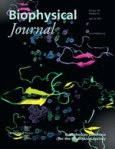The combination of experimental and computational biophysics is crucial to the study intrinsically disordered proteins like amyloid-β (Aβ), and I wanted to submit an image that captures the complimentary use of these techniques as our cover art. The image I created reflects the use of NMR experiments and molecular dynamics simulations in generating an accurate picture of the structural differences between the Ab40 and Ab42 Alzheimer’s peptides. The background contours are a portion of the NOE (Nuclear Overhauser Effect) NMR spectrum from the Ab40 (top) and Ab42 (bottom) peptides. The structures in the foreground are snapshots from molecular dynamics simulations of the two peptides. Since our article focuses on the differences in the β-strands formed by the two peptides, the snapshots presented here are the β-strand conformations formed by Ab40 (pink) and Ab42 (yellow) as monomers. The size of the structure in the image is roughly correlated with how populated that β-sheet is in the monomer ensemble.
intrinsically disordered proteins like amyloid-β (Aβ), and I wanted to submit an image that captures the complimentary use of these techniques as our cover art. The image I created reflects the use of NMR experiments and molecular dynamics simulations in generating an accurate picture of the structural differences between the Ab40 and Ab42 Alzheimer’s peptides. The background contours are a portion of the NOE (Nuclear Overhauser Effect) NMR spectrum from the Ab40 (top) and Ab42 (bottom) peptides. The structures in the foreground are snapshots from molecular dynamics simulations of the two peptides. Since our article focuses on the differences in the β-strands formed by the two peptides, the snapshots presented here are the β-strand conformations formed by Ab40 (pink) and Ab42 (yellow) as monomers. The size of the structure in the image is roughly correlated with how populated that β-sheet is in the monomer ensemble.
Science is part of the liberal arts, and visual presentation is one way we see that art can be used to enhance the communication of science. I try to think carefully about the visual presentation of my scientific work because it can make a large difference in how the work is viewed and interpreted, but also because I feel that these images are beautiful and that this artistry should be perceived by others. The NOE spectrum in particular I found to be elegant in its simplicity, which made a nice contrast to the disorder and complexity of the ensemble of peptide structures in our simulations. I hope that the striking colors and patterns of the image draw the viewer in, triggering an interest in what this image tells us about the Aβ peptides and how both the computational and experimental techniques provide a piece of that puzzle.
Having just finished my PhD in Biophysics, I am particularly delighted to have this paper and cover published in Biophysical Journal. Because I work on projects that incorporate biology and physics as well as computation and experiment, crossing disciplines has become familiar to me, and I am glad to be able to merge the boundary between art and science now as well.
Websites:
Prof. Teresa Head-Gordon: http://thglab.berkeley.edu/Site/Home.html
Prof. David Wemmer: http://www.cchem.berkeley.edu/wemmer/home.html
Dr. K. Aurelia Ball: http://www3.decf.berkeley.edu/~kball/
The structure of ABeta 1-40 has actually been solved at high resolution (.72 RMSD in the ordered region) in the absence of detergents or organic solvents that may affect folding. While this is likely not the only structure ABeta can adopt, it would make an excellent starting point for simulations.
PDB 2LFM
http://www.sciencedirect.com/science/article/pii/S0006291X11011144